

The World at Night (TWAN) in Photos and Videos. How Humans Helped the Earth in 2010: Slide Show. Ridding the Earth of Plastic From boom to bust, the reputation of plastics since World War II has gone from revolutionary dream invention to environmental nightmare.
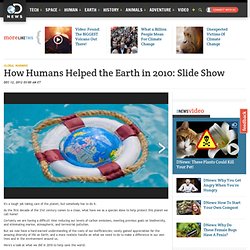
Degradable plastics break down into smaller pieces, leaching chemicals such as bisphenol A (BPA) into the water. Pieces of plastic are often mistaken for food among marine and desert animals alike -- with lethal consequences. Cutting back on the pervasive use of plastics in society is practically impossible, but helping to improve biodegradability, identifying new alternative materials, researching the ocean’s plastic-laden gyres, recycling plastic in new ways, and banning the use of plastic bags shows that in 2010 humans took the problem of plastic to the bank. In Agra, India, home of the Taj Mahal, plastic bags and bottles blocked drains during the monsoon season. Ocean Dead Zones. Earth, Ocean, & Environmental Science.
Visible Earth: Browse by Sensor. Image of the Day. Earth Science Picture of the Day. OurAmazingPlanet.com. Photo of the Day Archive. Total Lunar Eclipse This Weekend—Last One Until 2014. This weekend sky-watchers across most of the globe will have the chance to watch at least some of the last total lunar eclipse until 2014.
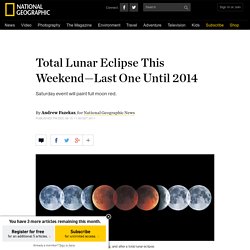
The entire lunar eclipse will be visible in East Asia, Australia, and the far western portion of North America that includes Alaska and Canada's Yukon and Northwest Territories. The spectacle will last nearly three and a half hours, starting on Saturday at 4:45 a.m. Pacific Time. Totality—when the full moon will be completely blocked from direct sunlight—will start at 6:05 a.m. PT and last until 6:57 a.m. Extreme Weather Photo Contest Winners. Thank you to everyone who submitted photos to the first installment of our GPM Extreme Weather Photo Competition.
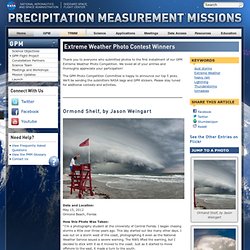
We loved all of your entries and thoroughly appreciate your participation! The GPM Photo Competition Committee is happy to announce our top 5 picks. We’ll be sending the submitters NASA bags and GPM stickers. Please stay tuned for additional contests and activities. Ormond Shelf, by Jason Weingart Date and Location: May 15, 2012 Ormond Beach, Florida How this Photo Was Taken: “I'm a photography student at the University of Central Florida. I have shot many storms from the same spot this photo was taken, and I almost drove by to get a different vantage point, but something told me to just stop at my spot. The storm actually pushed back on shore as it moved south, and then became strong enough for tornado warnings on three separate occasions. Fun Fact: A shelf cloud is a type of arcus cloud with a wedge shape. Earth. GLOBAL CLIMATE CHANGE from JPL Your planet is changing.
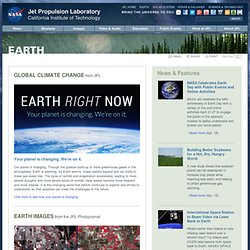
We're on it. Our planet is changing. European Geosciences Union. Climate Change: Vital Signs of the Planet. Smithsonian Institution. Earth from Space. An Ancient Universe - Earth. Earth...Just A Click Away.
How Far Away is the Horizon? On a clear day, you can see for miles and miles and miles.
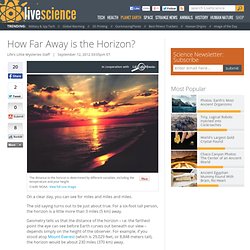
The old saying turns out to be just about true. For a six-foot tall person, the horizon is a little more than 3 miles (5 km) away. Geometry tells us that the distance of the horizon – i.e. the farthest point the eye can see before Earth curves out beneath our view – depends simply on the height of the observer.
For example, if you stood atop Mount Everest (which is 29,029 feet, or 8,848 meters tall), the horizon would be about 230 miles (370 km) away. Add the effect of refraction, which bends rays of light as they pass through the atmosphere, and the horizon is even farther. Plus, since clouds hover above ground level, they can be seen to farther distances than features on Earth's surface. But just as weather sometimes aids our view, it can also hinder it.
Infographic: Tallest Mountain to Deepest Ocean Trench. Karl Tate, OurAmazingPlanet | June 07, 2010 01:14pm ET Buy This Infographic as a Full-Size Poster You can purchase an 18"x72" poster of this infographic on high-quality 14G Photo Paper from the LiveScience.com store here: Buy Poster Embed: Paste the code below into your site.
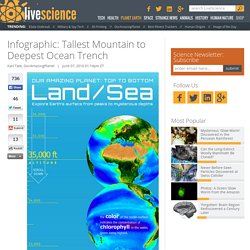
<a href=" alt="Oap-landsea-oceans-100608-moderate" src=" /></a><br/>Source: <a href=" Infographic: Tallest Mountain to Deepest Ocean Trench</a> Earth. Australia. In a certain present there is more of the future than in the future. Ask-A-Geologist. Drill to Earth's Mantle. (PhysOrg.com) -- In what can only be described as a mammoth undertaking, scientists, led by British co-chiefs, Dr Damon Teagle of the National Oceanography Centre in Southampton, England and Dr Benoit Ildefonse from Montpellier University in France, have announced jointly in an article in Nature that they intend to drill a hole through the Earth’s crust and into the mantle; a feat never before accomplished, much less seriously attempted.

The Earth’s mantle is the part of the planet that lies between the crust and the iron ball at its center, and to reach it, would require drilling down from a position in the ocean, because the crust is much thinner there. Even still, it would mean drilling through five miles of solid rock. And if that doesn’t sound hard enough, temperatures increase the farther down you go, and could reach as high as 1,050 degrees Fahrenheit; high enough to render useless most modern drill bits.
Volcanoes. Chicxulub Crater. Earth Magnetic Field. Global Warming. Radiation Meltdown Everyone Exposed. Earth Growing? Environmental Working Group. Emergency and Disaster Information Service. 13 Months. Earth Paradigm.